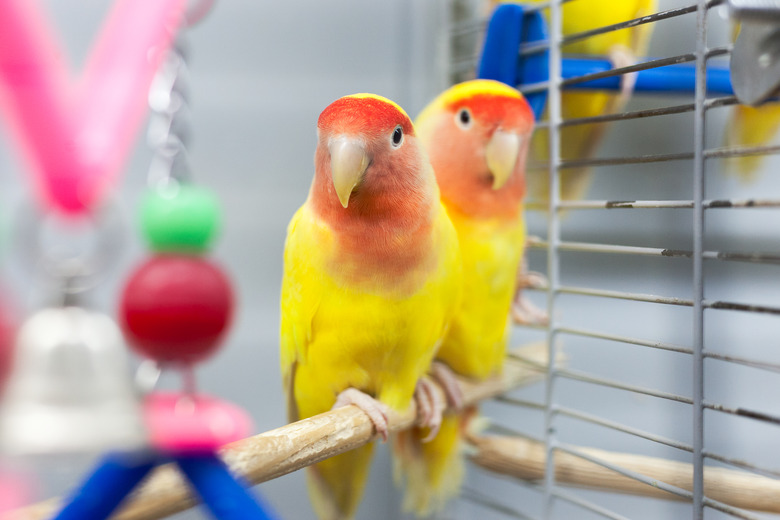The Difference Between Male & Female Lovebirds
It can be difficult to tell female and male love birds (or lovebirds) apart just by looking at them if your lovebirds are members of one of the species whose males and females have no color differentiation. If you own a pair, you stand a good chance of being able to determine your lovebirds' gender identity by observing their physical characteristics and behaviors. If you have a lovebird, male female differences may be hard to tell unless you have one of the dimorphic species.
Lovebirds color differences
Among the nine species of lovebirds, three species are dimorphic. This means that the males of these species have visible color differences from the females. The three species of lovebirds that fall into this category are the Madagascar lovebird, the red-faced lovebird and the Abyssinian lovebird.
The Madagascar lovebird is also known as the gray-headed lovebird. The head, breast and back of the neck on male birds will be gray against an otherwise green body, which gets darker on the back and wings. Females of this species are completely green. Male red-faced lovebirds are bright green with yellow coloration on their breasts and undersides. Males have orange-red faces and crowns with green and black wings. Females have faces that are more orange than red; their wings are entirely green.
The Abyssinian lovebird may also be called the black-winged lovebird. Males of this species are green with bright red coloration on their foreheads and surrounding their eyes. The areas under the wings are black on males. Females do not have any red on their heads, and the areas under their wings tend to be more greenish, though they may contain some black.
The rosy-faced lovebird is also known as the red-faced lovebird. or even the rosey cheeked lovebird. If you have a rosy faced lovebird, male and female differences can be hard to spot. Males have rosy pink foreheads, chins, throats, upper breasts and cheeks. The females have very similar but slightly more dull coloring.
Lovebird Male-Female Differences
Six lovebird species are monomorphic — there is no color difference between the males and the females. While coloring will not help you tell the males from the females in these breeds, there are some physical characteristics you can look for that may help you tell males and females apart.
Female lovebirds tend to have broader heads, broader shoulders and a wider pelvic span than males do. You can estimate the width of the head and shoulders with your eyes and compare the bird with others to hazard a guess whether your bird might be female. Males may have longer beaks than females.
Bird Pelvic Bones
A common way of checking a bird's gender is to measure the space between the bird's pelvic bones. Checking the pelvic width can pose a risk to your bird if you do not perform it properly. If you are unsure of your ability to handle your bird comfortably and safely, let an experienced veterinarian check your bird's pelvic width for you or teach you how to do it.
Typically, you'll gently but firmly hold a lovebird so that the back is against your palm and the head is sticking out between your second and third fingers. Rub your finger between the bird's legs, feeling for the two bones located right above the tail. If the bones are close together, the bird is likely male. If the bones are slightly further apart — large enough that an egg could fit through the pelvis — your bird is likely female.
Vent sexing is another way to identify a bird's gender. Vent sexing requires manipulating the bird's vent by hand to observe the genitalia. Only a veterinarian or bird-handling professional should undertake vent sexing.
Gender differences in lovebirds
You may be able to determine your lovebirds' gender identity by observing their behavior. Females are more likely to display nesting behavior, such as tearing up or shredding items that are put in the cage. Females are considered more likely to behave in a territorial or aggressive manner. If a lovebird lays eggs, you can guarantee that she is female.
If that doesn't work, ask your veterinarian. A sample of your bird's DNA can be used to determine whether the bird is male or female. DNA testing is by far the most reliable method for determining gender of young lovebirds. An experienced avian veterinarian can take the lead in DNA-testing your birds, or you can test from home using a kit you'll send to the manufacturer for testing.
Lutino lovebirds
The lutino lovebird is a color variation of the peach-faced lovebird. It is considered a sex-linked mutation. The lutino mutation occurs when dark melanin pigment is absent from the bird. While the gene that causes lutino coloration is linked to the sex chromosomes, it is not exclusive to males or females and will not help you determine gender. Male and female lutino lovebirds are monomorphic.
